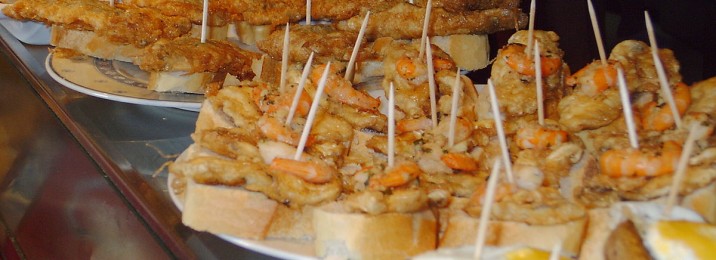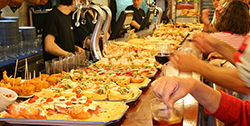What’s New In Tapas - Pais Vasco
Pais Vasco
The people of Pais Vasco (Euskadi in Basque, or Basque Country in English) are passionate about their food, and it’s everywhere you look. In every bar, every cider house (sagardotegiak), every men’s club (txokos, meant for cooking and eating together), their unique and innovative style of cuisine has become a symbol of their independence from Spain – and the ubiquitous pintxos, though superficially similar to tapas, are actually very different.
The typical pintxo (pronounced pin-cho, literally meaning ‘spike’) is held to a slice of bread by a cocktail stick, creating a distinctive sight when they’re all laid out on the bar. They’re also self-service, unlike tapas, which are often prepared to order and brought to your table. Traditionally, customers have helped themselves to the pintxos and kept count of what they’ve eaten by saving each cocktail stick. Also unlike tapas, pintxos can’t be upgraded to a larger portion (e.g. from a tapa to a ración); they’re devised as single servings, and each pintxo is a self-contained whole. They’re like canapes in this sense, and are more of a showcase of the chef’s ingenuity or technique than a mere celebration of local ingredients. In fact, pintxos often draw on international influences and foreign cuisine.
“Pinchos bermeo 2” by I, Telle. Licensed under CC BY-SA 3.0 via Wikimedia Commons
Hence, pintxos are typically far more complex and impressive than tapas; they’re really the main event, whereas in the rest of Spain, these snacks are (historically, at least) secondary to the wine or beer drank with them.
In that spirit, going for pintxo (going on what is called a txikiteo or poteo) is usually a more formal affair than casually bar-hopping for tapas. Once or twice a week, usually at the weekend, people meet up with a specific group of between five and fifteen members (usually of the same sex) called a cuadrilla. They pool their money and put someone in charge of ordering for everybody. Since each bar is known for a particular speciality, ordering is not so complicated, and people in a cuadrilla stick to the same drink all evening – whether this be a zurito (small beer), ardo beltz (“black” or red wine), txakoli (a light regional white), or a glass of the famous Basque sidra (cider).
Pintxos are crucial not only to everyday socialising, but also to the Basque expression of regional identity. The Basques therefore consider it vital to preserve this tradition, but it nonetheless seems to be changing.
Traditional and regional ingredients are still very common. Peppers are used extensively and are celebrated each year in the festival at Ezpeleta (Espelette), a town known for its dried red pimientos. Other vegetables include asparagus, artichokes, mushrooms, and tomatoes. Fish is also extremely common – especially cod, hake, and anchovies. As in Catalonia, ‘surf and turf’ combinations are popular.
One of the oldest and most characteristic pintxos that continues to draw in crowds is the kokotxas al pil pil – hake or cod cheeks in a garlic, chilli, and olive oil sauce. Others include gilda (anchovy, guindilla pepper, olive and olive oil), brocheta de gambas (prawns with a vinaigrette of garlic, peppers and onion), and tigres (mussels in a tomato and mayonnaise sauce).
In San Sebastián (Basque: Donostia), the region’s so-called pintxo capital, there’s a broad mixture of old
and new recipes. Recently voted the best of the best in a city renowned for its food (and in which the high cost of opening a restaurant keeps the standard very high too), the centrally located Bar Antonio serves mostly traditional fare; the light igueldo (anchovies, tuna, tomato, and green pepper), and classic antxoas (anchovies with green pepper) are especially popular. Another bar, Alberto, is also very good for typically Basque pintxos, including meatballs in a thick meat sauce and baby squid served in its own ink.
Elsewhere in the city, bars like Zeruko are more adventurous. La Hoguera (the bonfire) is a very loosely termed pintxo consisting of cod that has been only half-smoked, leaving the customer to finish it off to their own liking. Other inspired options include foie gras with pineapple and passion fruit, and guacamole toast with salmon eggs. Txpetxa, on Calle Pescaderia, is also very innovative, serving anchovies in every which-way imaginable (and sometimes unimaginable), such as with cream of spider crab or blueberry jam. Haizea in the Old Quarter, meanwhile, brings together the old and new rather artfully by presenting traditional ingredients in an avant-garde manner: stuffed prawns, for instance, or a cod, onion, and bechamel cream encased in a filo pastry “brick”.
The txikiteo itself is also being evolved in some small way by San Sebastián restaurateurs – especially as an activity for tourists. The recently introduced Pintxo Box contains a guide to the best bars, and a number of tokens for use on their pintxos and drinks.
In Bilbao (Basque: Bilbo), the regional capital, there’s a greater sensitivity to tradition, and seemingly a growing demand for local flavors. Cafeteria Restaurante Deutsoarrak, for instance, on Madariaga Avenue, won the “Gold Stick” award in the “Best New Establishment” category of the 2013 Bilbao-Bizkaia Txapelketa Pintxo Bar Contest, and is known for traditional meats, pates, and fish. Other popular bars include Xukela, which serves regional cheeses, hams, peppers, anchovies and salted cod, and La Viña del Ensanche for squid, octopus, and hake. Rimbombin is another bar known for its range of traditional seafood pintxos.
In the region’s third largest city, however – Vitoria (Basque: Gasteiz) – the hugely popular Sidrería Sagartoki specialises in reinventing traditional pintxos, often in very playful and subversive ways: for instance, the ham and cheese lollipops or fried egg in a potato parcel.
In summary, there doesn’t seem to be any discernible trend among the Basque pintxo bars; old and new, local and international all seem to coexist with equal measures of success. One thing is clear, though: the Basque pintxo chefs remain devoted to their most central tradition of all – to keep the standard of their cuisine impeccably high.



No comments
You can be the first one to leave a comment.